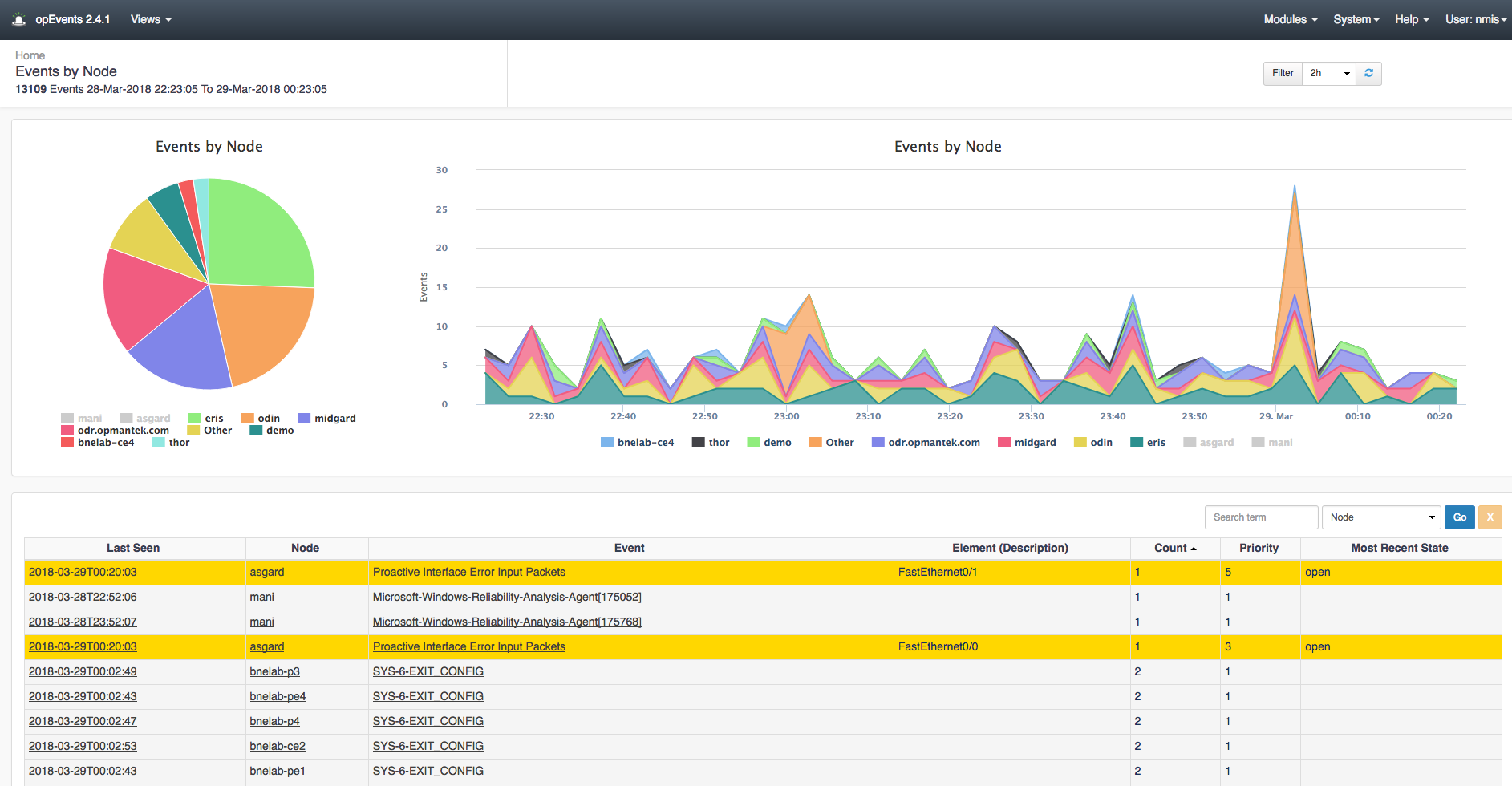| Table of Contents |
|---|
...
opEvents Views
The default view in opEvents shows the Dashboard which opEvents home page gives you a snapshot of all the nodes, events, and issues in your environment in a simple, easy-to-grasp graphical and tabular formats. It displays the Events by Node, filtered according to the specified time and event filters. From this page, you can also access the current/escalated events, actions taken, summary reports, unprocessed/raw logs, archived logs, etc.
Dashboard View
By default, opEvents opens in the Dashboard view that displays the Events by Node. It lists the devices that you can visually see which devices are generating the most number of events.Clicking on the pie chart or the graph to the right of it allows you to drill into the events of a specific device or the list of events that occurred in specific time periods. Clicking on the device name at the bottom of the Events by Node charts allows you to filter out devices you do not want to display on the charts granting you the ability to customize your charts view.
- Use the time Filter function located at the top right corner of the chart to specify the particular time period you want to look for the events in.
- Hover over a segment of the pie chart to see the device name.
- Click on a segment for a comprehensive look at the events on the specific device, occurred during the indicated time period.
- If you don't want to display a specific device on the chart/graph, you can filter it out by clicking on its name in the legend below the chart/graph.
In the table below the two charts, you can see the time of the event, the node, the event name, description of the event, the amount number of times this the event occurred, the priority, and the most recent state of the node. These can be sorted by event count, priority, event name, or which ever makes finding relevant events easier. The table also has a search field located above the count column making finding specific events quickly.
With the time filter located in the top right of the chart you can filter the time period to view events generated during certain time windows.
- Click on a column name/heading to sort the events list by ascending or descending order and find the required events more easily.
- Use the Search field above the table to find a specific event quickly. You can also narrow the search by selecting a column name from the drop-down list beside the Search field.
Nodes View
To view a list of all the nodes in your environment and a summary of their properties, from the top menu bar, click Views > Nodes.
On any of the pages in the menu -> Views drop down menu you can click on the event Name, Node, Last Seen, Title, etc. and drill into more granular details. In the example below I am clicking the link to the device "asgard" which opens up the "Node Context" page.
...
Archive Logs view lets you see the archived logs along with their type of log and an Entry description. The Filter on the top right of the page lets you choose how many days you want to look back for these logs depending on your log rotation setup. As with other views, this page can be Exported to CSV by clicking the Export to CSV by clicking the button to the left of the Show drop down menu which will allow for more events to be displayed on the page. Clicking the links within the Archive column will open up an Archive Logs Details page that displays the _id of the event along with the details from the Archive Logs view pertaining to that particular event. These items on the table can also be customized to your liking by adding or taking away information displayed on this page. These changes can be made by navigating to /usr/local/omk/conf/table_schemas and editing the opEvents_archive-log.json file. For more information on this process we have documentation that goes into more detail on how to edit these values here: opEvents 2.4.x - Customising Table Columns.
Nodes View
The Nodes View displays a list of all Nodes, their Group, Location, Customer, Business Service(s), and their Host. This view allows you to quickly search for a specific node to view it's events by using the search box in the top right of the page. If desired you can click the Export to CSV button to generate a copy of this page in CSV format. This button is located to the left of the Show drop down menu. The show drop down menu lets you choose how many devices to display on the page. Clicking on a node in the Name column will open up the devices Node Context page allowing you to view more detailed information.
...


